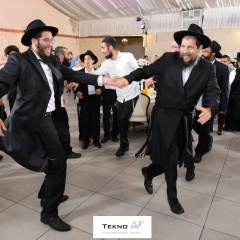Тайна возвращения
Из бесед Любавичского Ребе
На страницах Гемары возник спор, как Всевышний прощает наши проступки в Йом-Кипур. Мудрецы считают, что это возможно, только если сам еврей сделал тшуву, раскаялся в своих грехах. А рабби Еуда а-Наси утверждает: “Раскаялся или не раскаялся, Йом-Кипур все равно стирает его грех”. (Швуот, 13а)
Нужно верно очертить границы спора. И рабби Еуда, и его товарищи, сходятся в том, что сила прощения и исправления, заложенная в природу этого дня, обладает гораздо большей мощью, чем сила раскаяния отдельного человека. Но мудрецы полагают, что ключом к тайне этого дня все-таки является личная тшува. А рабби Еуда говорит: даже если еврей не сумел сделать тшуву, он будет прощен.
Галаха идет по мнению мудрецов. Первая декада Тишри, куда входит День Искупления, называется “десятью днями тшувы”. Столь серьезная подготовка нужна, чтобы душа еврея прошла очищение самым полным и возвышенным образом. Но и мнение рабби Еуды тоже обладает должным весом. Его слова можно понять так: какой бы глубокой не была тшува еврея, она не сможет сравниться с тем очищением, которое приходит к нам в этот день. Мы возвращаемся к Б-гу, а Он нас ВОЗВРАЩАЕТ, превосходя все доступные человеку рамки и границы.
Работа тшувы
Говоря о путях прощения и искупления, можно выделить несколько ступеней: 1. Всевышний обьявляет “амнистию”, отменяя наказание за допущенный грех. 2. Однако от каждого нашего поступка остается “рошем”, отпечаток, мешающий служить Б-гу в чистоте и святости. Всевышний стирает это грязное пятно, будто его не было вовсе. 3. Более того: Он, Благословенный, способен “перевернуть” прошлые грехи и засчитать их, как заслуги.
“Работа тшувы” тоже складывается из нескольких частей. Стараясь исправить допущенное зло, человек возвращает старые долги, извиняется за резкие слова и пр. Менее заметно происходит внутренняя работа. Еврей старается вырвать с корнем удовольствие от плохих поступков, убивая тем самым его “душу греха”, которую он подарил миру нечистых оболочек. А когда он читает “видуй”, перечень своих проступков, то лишает грех “тела”. Поступая так, он стирает след от того или иного нарушения.
Но есть люди, у которых сила раскаяния настолько велика, что в душе просыпается жажда святости, неутихающие желание приблизиться к Творцу с еще большей силой, чем ты когда-то отдалялся от Него. Тогда выходит, что грехи “переворачиваются”, и то, что прежде тянуло вниз, во тьму, теперь толкает душу к свету.
Все сказанное требует от еврея огромного упорства и душевных сил, на что способны далеко не все. Но Йом-Кипур принимает к себе каждого еврея, помогая достичь вершин, о которых в остальные дни он не мог и помыслить…
В учении хасидизма существует понятие “иткашрут” – постоянная связь с источником святости, которая становится крепче день ото дня. Если говорить о связи еврея с Творцом, здесь тоже есть несколько ступеней.
Первая: еврей принимает на себя ярмо Небесной власти, постоянно соблюдает мицвот, заповеди Б-га, и готов исполнить любой Его приказ.
Вторая: предположим, что человек, вольно или невольно, отклонился от соблюдения заповедей. Но его связь со Всевышним ослабла только внешне, а сердце, наоборот, пробудилось и “грызет” еврея, требуя сделать тшуву. Источник этой силы очень глубок и дает возможность залечить старые рубцы и шрамы – последствия греха. Однако “тшува сердца” тоже имеет рамки, она не безгранична.
Третья: связь корня еврейской души, который находится в высших мирах, с его Источником – Творцом. Это уровень, на котором отсутствуют границы и не происходят перемены. Сюда не доходят ни проступки еврея, ни те усилия, которые он прилагает, чтобы их исправить. Ведь любое наше действие имеет свою форму и предел, что предполагает возможность перемены. А Всевышний безграничен и неизменен, являясь “Простым Единством”, которое объемлет все. На “нефеш элокит”, Б-жественную душу еврея, тоже падает отсвет этих качеств. В Тании говорится, что она является частью Творца и связана с Ним неразрывно.
Какие бы проступки не совершал еврей в нижнем мире, его главная связь с Б-гом существует вечно. Однако весь год эта связь пребывает в сокрытии, и только в Йом-Кипур корень еврейской души раскрывается в нашем мире, давая каждому еврею ощутить, НАСКОЛЬКО он связан со Всевышним.
Невидимое чудо
Когда корень души еврея светит внизу, проникая во все уголки нашей души, то проступки, или даже след от них, теряют право на существование. Это имел в виду рабби Еуда, говоря, что Йом-Кипур искупает даже те грехи, в которых еврей еще не успел раскаяться.
Зачем же тогда нужна тшува? Почему не продлить чудо Йом-Кипура на весь год? Но не меньшим чудом является будничная работа каждого еврея. Исправляя душу и все, что вокруг, он старается, не покидая материального мира, стать ближе к Б-гу,- и тем самым привлекает Его к нам, готовя Творцу “жилище среди нижних”.
Невидимое чудо, происходящее раз в году, в день прощения и искупления, когда Сущность Б-га раскрывается в душе еврея, соединяя земное и небесное, станет постоянным свойством бытия, открытым и понятным для всех. Служение каждого из нас приближает этот миг, и поэтому слова рабби Еуда а-наси должны быть верно поняты. Когда он говорит, что сам Йом-Кипур очищает и исправляет проступки еврея, это не значит, что можно бездействовать. И рабби Еуда, и остальные мудрецы согласны в том, что еврей должен воздерживаться от пищи и соблюдать другие запреты этого поста-праздника. Если человек не признает ограничений, которые накладывает день прощения и искупления, то и Йом-Кипур не признает его.
Пусть будет свет в еврейских жилищах, и пусть все мы удостоимся хорошей записи в наступившем году, а печать Творца придаст ей вес и силу!
От Эзры Ховкина
Из бесед Любавичского Ребе
На страницах Гемары возник спор, как Всевышний прощает наши проступки в Йом-Кипур. Мудрецы считают, что это возможно, только если сам еврей сделал тшуву, раскаялся в своих грехах. А рабби Еуда а-Наси утверждает: “Раскаялся или не раскаялся, Йом-Кипур все равно стирает его грех”. (Швуот, 13а)
Нужно верно очертить границы спора. И рабби Еуда, и его товарищи, сходятся в том, что сила прощения и исправления, заложенная в природу этого дня, обладает гораздо большей мощью, чем сила раскаяния отдельного человека. Но мудрецы полагают, что ключом к тайне этого дня все-таки является личная тшува. А рабби Еуда говорит: даже если еврей не сумел сделать тшуву, он будет прощен.
Галаха идет по мнению мудрецов. Первая декада Тишри, куда входит День Искупления, называется “десятью днями тшувы”. Столь серьезная подготовка нужна, чтобы душа еврея прошла очищение самым полным и возвышенным образом. Но и мнение рабби Еуды тоже обладает должным весом. Его слова можно понять так: какой бы глубокой не была тшува еврея, она не сможет сравниться с тем очищением, которое приходит к нам в этот день. Мы возвращаемся к Б-гу, а Он нас ВОЗВРАЩАЕТ, превосходя все доступные человеку рамки и границы.
Работа тшувы
Говоря о путях прощения и искупления, можно выделить несколько ступеней: 1. Всевышний обьявляет “амнистию”, отменяя наказание за допущенный грех. 2. Однако от каждого нашего поступка остается “рошем”, отпечаток, мешающий служить Б-гу в чистоте и святости. Всевышний стирает это грязное пятно, будто его не было вовсе. 3. Более того: Он, Благословенный, способен “перевернуть” прошлые грехи и засчитать их, как заслуги.
“Работа тшувы” тоже складывается из нескольких частей. Стараясь исправить допущенное зло, человек возвращает старые долги, извиняется за резкие слова и пр. Менее заметно происходит внутренняя работа. Еврей старается вырвать с корнем удовольствие от плохих поступков, убивая тем самым его “душу греха”, которую он подарил миру нечистых оболочек. А когда он читает “видуй”, перечень своих проступков, то лишает грех “тела”. Поступая так, он стирает след от того или иного нарушения.
Но есть люди, у которых сила раскаяния настолько велика, что в душе просыпается жажда святости, неутихающие желание приблизиться к Творцу с еще большей силой, чем ты когда-то отдалялся от Него. Тогда выходит, что грехи “переворачиваются”, и то, что прежде тянуло вниз, во тьму, теперь толкает душу к свету.
Все сказанное требует от еврея огромного упорства и душевных сил, на что способны далеко не все. Но Йом-Кипур принимает к себе каждого еврея, помогая достичь вершин, о которых в остальные дни он не мог и помыслить…
В учении хасидизма существует понятие “иткашрут” – постоянная связь с источником святости, которая становится крепче день ото дня. Если говорить о связи еврея с Творцом, здесь тоже есть несколько ступеней.
Первая: еврей принимает на себя ярмо Небесной власти, постоянно соблюдает мицвот, заповеди Б-га, и готов исполнить любой Его приказ.
Вторая: предположим, что человек, вольно или невольно, отклонился от соблюдения заповедей. Но его связь со Всевышним ослабла только внешне, а сердце, наоборот, пробудилось и “грызет” еврея, требуя сделать тшуву. Источник этой силы очень глубок и дает возможность залечить старые рубцы и шрамы – последствия греха. Однако “тшува сердца” тоже имеет рамки, она не безгранична.
Третья: связь корня еврейской души, который находится в высших мирах, с его Источником – Творцом. Это уровень, на котором отсутствуют границы и не происходят перемены. Сюда не доходят ни проступки еврея, ни те усилия, которые он прилагает, чтобы их исправить. Ведь любое наше действие имеет свою форму и предел, что предполагает возможность перемены. А Всевышний безграничен и неизменен, являясь “Простым Единством”, которое объемлет все. На “нефеш элокит”, Б-жественную душу еврея, тоже падает отсвет этих качеств. В Тании говорится, что она является частью Творца и связана с Ним неразрывно.
Какие бы проступки не совершал еврей в нижнем мире, его главная связь с Б-гом существует вечно. Однако весь год эта связь пребывает в сокрытии, и только в Йом-Кипур корень еврейской души раскрывается в нашем мире, давая каждому еврею ощутить, НАСКОЛЬКО он связан со Всевышним.
Невидимое чудо
Когда корень души еврея светит внизу, проникая во все уголки нашей души, то проступки, или даже след от них, теряют право на существование. Это имел в виду рабби Еуда, говоря, что Йом-Кипур искупает даже те грехи, в которых еврей еще не успел раскаяться.
Зачем же тогда нужна тшува? Почему не продлить чудо Йом-Кипура на весь год? Но не меньшим чудом является будничная работа каждого еврея. Исправляя душу и все, что вокруг, он старается, не покидая материального мира, стать ближе к Б-гу,- и тем самым привлекает Его к нам, готовя Творцу “жилище среди нижних”.
Невидимое чудо, происходящее раз в году, в день прощения и искупления, когда Сущность Б-га раскрывается в душе еврея, соединяя земное и небесное, станет постоянным свойством бытия, открытым и понятным для всех. Служение каждого из нас приближает этот миг, и поэтому слова рабби Еуда а-наси должны быть верно поняты. Когда он говорит, что сам Йом-Кипур очищает и исправляет проступки еврея, это не значит, что можно бездействовать. И рабби Еуда, и остальные мудрецы согласны в том, что еврей должен воздерживаться от пищи и соблюдать другие запреты этого поста-праздника. Если человек не признает ограничений, которые накладывает день прощения и искупления, то и Йом-Кипур не признает его.
Пусть будет свет в еврейских жилищах, и пусть все мы удостоимся хорошей записи в наступившем году, а печать Творца придаст ей вес и силу!
От Эзры Ховкина
Mystery of return
From conversations of the Lubavitcher Rebbe
A controversy arose on the pages of Gemara about how the Almighty forgives our transgressions in Yom Kippur. The sages believe that this is possible only if the Jew himself made teshuva, repented of his sins. And Rabbi Yehuda a-Nasi claims: “Repented or not repented, Yom Kippur still erases his sin.” (Shvuot, 13a)
It is necessary to correctly outline the boundaries of the dispute. Both Rabbi Yehuda and his comrades agree that the power of forgiveness and correction laid down in the nature of this day has much greater power than the power of repentance of an individual. But the sages believe that the key to the mystery of this day is still personal tshuva. And Rabbi Yehuda says: even if a Jew did not manage to do teshuv, he will be forgiven.
Halakha is according to the sages. The first decade of Tishri, which includes the Day of Atonement, is called the “ten days of teshuvah.” Such serious preparation is necessary for the soul of a Jew to undergo purification in the most complete and sublime way. But the opinion of Rabbi Yehuda also has due weight. His words can be understood as follows: no matter how deep the Jew’s teshuva is, it cannot be compared with the purification that comes to us on this day. We return to Gd, and He RETURNS us, surpassing all the frames and boundaries available to man.
Tshuva work
Speaking about the ways of forgiveness and atonement, several stages can be distinguished: 1. The Most High declares an “amnesty”, abolishing the punishment for a sin committed. 2. However, from each of our deeds, there remains a “rush”, an imprint that impedes serving Gd in purity and holiness. The Almighty erases this dirty stain, as if it were not there at all. 3. Moreover: He, the Blessed One, is able to “turn over” past sins and count them as merit.
“Tshuva work” also consists of several parts. Trying to correct the evil that has been committed, a person repays old debts, apologizes for harsh words, etc. Internal work is less noticeable. The Jew is trying to uproot the pleasure of bad deeds, thereby killing his “soul of sin”, which he gave to the world of unclean shells. And when he reads “see,” a list of his misconduct, he robs sin of the “body.” By doing so, he erases the trace of a violation.
But there are people for whom the power of remorse is so great that a thirst for holiness awakens in the soul, an unquenchable desire to draw closer to the Creator with even greater power than you once moved away from Him. Then it turns out that sins are “turned over”, and that which was previously pulled down into darkness now pushes the soul to the light.
All that has been said requires tremendous perseverance and mental strength from a Jew, which not everyone is capable of. But Yom Kippur welcomes every Jew, helping to reach the heights, which he could not even think of on the other days ...
In the teaching of Hasidism, there is the concept of “itinerary” - a constant connection with the source of holiness, which is becoming stronger day by day. If we talk about the connection of the Jew with the Creator, there are also several steps.
First: the Jew takes upon himself the yoke of Heavenly authority, constantly observes the mitzvot, the commandments of God, and is ready to fulfill His every order.
Second: suppose that a person, voluntarily or involuntarily, deviated from keeping the commandments. But his connection with the Almighty only weakened externally, and his heart, on the contrary, woke up and “nibbles” the Jew, demanding to make teshuva. The source of this power is very deep and makes it possible to heal old scars and scars - the consequences of sin. However, “teshuva of the heart” also has a framework, it is not unlimited.
Third: the connection of the root of the Jewish soul, which is in the higher worlds, with its Source - the Creator. This is a level at which there are no boundaries and no changes. Neither the misconduct of the Jew, nor the efforts he makes to correct them, come here. After all, any of our actions has its own form and limit, which suggests the possibility of change. And the Almighty is unlimited and unchanging, being the “Simple Oneness” that encompasses everything. The “nefesh elokit”, the Divine soul of a Jew, also receives a reflection of these qualities. In Tania it is said that it is part of the Creator and is inextricably linked with Him.
Whatever misconduct a Jew makes in the lower world, his main connection with God exists forever. However, all the year this connection is in hiding, and only in Yom Kippur the root of the Jewish soul is revealed in our world, giving each Jew the feel of HOW much he is connected with the Almighty.
Invisible miracle
When the root of the soul of a Jew shines below, penetrating into all corners of our soul, then misconduct, or even a trace of them, lose their right to exist. This was meant by Rabbi Yehud, saying that Yom Kippur even atones for the sins that the Jew had not yet repented of.
Why then do you need teshuva? Why not extend the miracle of Yom Kippur for the whole year? But no less a miracle is the everyday work of every Jew. Correcting the soul and everything around him, he tries, without leaving the material world, to become closer to Gd, and thereby attracts Him to us, preparing the Creator “a dwelling among the lower ones”.
An invisible miracle that happens once a year, on the day of forgiveness and redemption, when the Essence of Gd is revealed in the soul of a Jew, combining the earthly and heavenly,
From conversations of the Lubavitcher Rebbe
A controversy arose on the pages of Gemara about how the Almighty forgives our transgressions in Yom Kippur. The sages believe that this is possible only if the Jew himself made teshuva, repented of his sins. And Rabbi Yehuda a-Nasi claims: “Repented or not repented, Yom Kippur still erases his sin.” (Shvuot, 13a)
It is necessary to correctly outline the boundaries of the dispute. Both Rabbi Yehuda and his comrades agree that the power of forgiveness and correction laid down in the nature of this day has much greater power than the power of repentance of an individual. But the sages believe that the key to the mystery of this day is still personal tshuva. And Rabbi Yehuda says: even if a Jew did not manage to do teshuv, he will be forgiven.
Halakha is according to the sages. The first decade of Tishri, which includes the Day of Atonement, is called the “ten days of teshuvah.” Such serious preparation is necessary for the soul of a Jew to undergo purification in the most complete and sublime way. But the opinion of Rabbi Yehuda also has due weight. His words can be understood as follows: no matter how deep the Jew’s teshuva is, it cannot be compared with the purification that comes to us on this day. We return to Gd, and He RETURNS us, surpassing all the frames and boundaries available to man.
Tshuva work
Speaking about the ways of forgiveness and atonement, several stages can be distinguished: 1. The Most High declares an “amnesty”, abolishing the punishment for a sin committed. 2. However, from each of our deeds, there remains a “rush”, an imprint that impedes serving Gd in purity and holiness. The Almighty erases this dirty stain, as if it were not there at all. 3. Moreover: He, the Blessed One, is able to “turn over” past sins and count them as merit.
“Tshuva work” also consists of several parts. Trying to correct the evil that has been committed, a person repays old debts, apologizes for harsh words, etc. Internal work is less noticeable. The Jew is trying to uproot the pleasure of bad deeds, thereby killing his “soul of sin”, which he gave to the world of unclean shells. And when he reads “see,” a list of his misconduct, he robs sin of the “body.” By doing so, he erases the trace of a violation.
But there are people for whom the power of remorse is so great that a thirst for holiness awakens in the soul, an unquenchable desire to draw closer to the Creator with even greater power than you once moved away from Him. Then it turns out that sins are “turned over”, and that which was previously pulled down into darkness now pushes the soul to the light.
All that has been said requires tremendous perseverance and mental strength from a Jew, which not everyone is capable of. But Yom Kippur welcomes every Jew, helping to reach the heights, which he could not even think of on the other days ...
In the teaching of Hasidism, there is the concept of “itinerary” - a constant connection with the source of holiness, which is becoming stronger day by day. If we talk about the connection of the Jew with the Creator, there are also several steps.
First: the Jew takes upon himself the yoke of Heavenly authority, constantly observes the mitzvot, the commandments of God, and is ready to fulfill His every order.
Second: suppose that a person, voluntarily or involuntarily, deviated from keeping the commandments. But his connection with the Almighty only weakened externally, and his heart, on the contrary, woke up and “nibbles” the Jew, demanding to make teshuva. The source of this power is very deep and makes it possible to heal old scars and scars - the consequences of sin. However, “teshuva of the heart” also has a framework, it is not unlimited.
Third: the connection of the root of the Jewish soul, which is in the higher worlds, with its Source - the Creator. This is a level at which there are no boundaries and no changes. Neither the misconduct of the Jew, nor the efforts he makes to correct them, come here. After all, any of our actions has its own form and limit, which suggests the possibility of change. And the Almighty is unlimited and unchanging, being the “Simple Oneness” that encompasses everything. The “nefesh elokit”, the Divine soul of a Jew, also receives a reflection of these qualities. In Tania it is said that it is part of the Creator and is inextricably linked with Him.
Whatever misconduct a Jew makes in the lower world, his main connection with God exists forever. However, all the year this connection is in hiding, and only in Yom Kippur the root of the Jewish soul is revealed in our world, giving each Jew the feel of HOW much he is connected with the Almighty.
Invisible miracle
When the root of the soul of a Jew shines below, penetrating into all corners of our soul, then misconduct, or even a trace of them, lose their right to exist. This was meant by Rabbi Yehud, saying that Yom Kippur even atones for the sins that the Jew had not yet repented of.
Why then do you need teshuva? Why not extend the miracle of Yom Kippur for the whole year? But no less a miracle is the everyday work of every Jew. Correcting the soul and everything around him, he tries, without leaving the material world, to become closer to Gd, and thereby attracts Him to us, preparing the Creator “a dwelling among the lower ones”.
An invisible miracle that happens once a year, on the day of forgiveness and redemption, when the Essence of Gd is revealed in the soul of a Jew, combining the earthly and heavenly,

У записи 11 лайков,
0 репостов,
364 просмотров.
0 репостов,
364 просмотров.
Эту запись оставил(а) на своей стене Хаим Толочинский
































